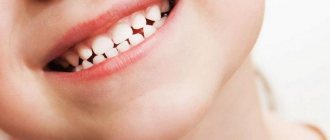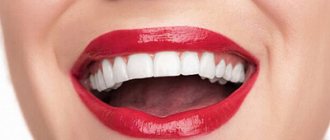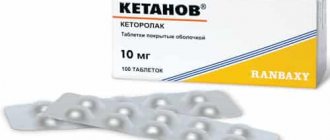Why do teeth crumble in adults?
Causes of tooth decay
Habits that ruin your teeth
What to do to strengthen enamel
Prevention from destruction
Not everyone can boast of healthy and strong teeth. The reason is simple: most of us come to the dentist only when faced with serious problems. One of them is the destruction of enamel: teeth literally begin to crumble into small pieces. Why does this happen and how to strengthen weak enamel?
My baby is teething - how can I help him?
The child's profuse salivation will tell you that the first tooth is on the way. 1-2 months before the first tooth erupts, the baby’s saliva begins to flow so actively that it is already difficult to do without aprons and bibs.
All your older relatives will probably tell you about the unpleasant side effects of teething. However, there are many misconceptions here.
The very first teeth usually come out painlessly. What most often happens is this: while spoon-feeding a child, the mother hears the sound of metal on the edge of a tooth - that is, she detects an event that has already happened, without even noticing anything unusual in the child’s behavior.
The emergence of canines and molars may be more difficult. The baby may be capricious, refuse to eat, sleep poorly, and put everything in his mouth. You should take care of inflamed gums - regularly treat them with special gels, offer your child to chew a cooling ring (cold relieves pain well).
However, do not believe that an increase in temperature is associated with teething. Fever and catarrhal symptoms are caused by an infection that is “caught” by the child’s body, weakened by malnutrition and lack of sleep. That is why, during the period of teething, it is better to protect the baby from communicating with strangers. Digestive disorders, an upset stomach of a child at the time of teething, is associated with his desire to chew and suck everything he can reach, just to relieve discomfort in the gums. This is how pathogenic microbes enter his mouth. Try to surround your child with clean objects, wash his hands and toys more often. Regularly let your baby chew small pieces of solid food - dried bread, bagel, apple slice, etc. This will help the teething of those teeth that are already “on the way”, improve blood supply, and therefore nutrition of the gums, develop the chewing reflex, and help the formation of the speech apparatus.
Causes of tooth decay
It happens that the enamel becomes fragile, cannot cope with the load and begins to crumble. Typically this process begins with the formation of small microcracks. Over time, they increase, leading to chips.
Tooth decay is influenced by many factors, both natural and mechanical.
- Poor hygiene. The accumulation of tartar and soft deposits create a favorable environment for the growth of bacteria. Those, in turn, release substances that destroy the enamel.
- Lack of vitamins and microelements that affect the formation of dental tissue, for example, vitamin D, calcium, phosphorus, etc.
- Abuse of sweets, alcohol, sour foods, seeds, smoking, sweet sodas. Simultaneous consumption of foods at different temperatures (ice cream and hot coffee).
- Bad habits: the habit of biting nails, a pen or pencil, opening a bottle with your teeth.
- Bruxism.
- Heredity.
- Diseases of the thyroid gland and endocrine system.
- Age-related changes.
- Pregnancy.
- Chronic diseases: arthritis, diabetes.
- Poor quality water.
Precautionary measures
Tips for avoiding chipped teeth follow general oral health tips:
- Visit your dentist regularly for dental examinations and professional teeth cleanings;
- taking vitamin and mineral complexes;
- brush your teeth morning and evening;
- limit the consumption of sweets, carbonated water, juices;
- do not smoke and limit alcohol consumption;
- treat teeth in the early stages of disease development;
- Treat diseases of organs and systems in a timely manner.
It is important to understand that an untreated tooth can lead to complications - from simple to very serious. Most often we are talking about caries, pulpitis, periodontitis. Doctors will confirm to you that a chipped tooth and infection can cause the development of chronic diseases of the heart, kidneys, stomach, liver, and nervous system.
INNOVASTOM offers an integrated approach to the treatment and prevention of dental and gum diseases in Smolensk. We are confident that we will help you maintain the health of your teeth!
Habits that ruin your teeth every day
| Regular sweet snacks form plaque and destroy enamel |
| Biting foreign objects creates cracks |
| Bruxism: Teeth grinding at night causes tooth wear |
| Large amounts of citrus fruits: acid destroys enamel |
| Drinks with bright pigments stain tooth enamel |
| Improper brushing of teeth destroys enamel and injures gums |
| Frequent whitening with folk remedies destroys enamel and increases sensitivity |
Treatment methods
The very first thing to do is to clean the canals - in the absence of a crown, carious inflammation can very quickly spread to a nearby nerve. After this, it is necessary to begin restoring the coronal part, i.e. the very top of the tooth. There are several best options for this.
Installation of a stump inlay A stump inlay is a modern alternative to pin-based extensions. A pin is simply a metal rod, while an inlay is created individually and accurately replicates the structure of the root system of a particular tooth. The result is a longer service life of both crown and root, as well as superior esthetics.
Price:
from 5,000 rubles more details about the solution
Installing a crown If the crown is destroyed to the level of the gingival margin, it is impossible to install only a filling - you need to think about prosthetic crowns. But such prostheses need support; the best option is to install a stump tab, which will strengthen the root system and create support for the prosthesis. Ceramic crowns are better suited for the front teeth, and metal-ceramic crowns for the side teeth. In both cases, an excellent solution would be zirconium dioxide prostheses - strong, aesthetic and very durable.
Price:
from 11,000 rubles more about the solution
Dental implantation This method is advisable to use when saving a tooth is not possible. And it is best to install the implant immediately after root removal. Thus, the preservation of bone tissue and its protection from rapid atrophy will be ensured. In some situations, especially when it comes to prosthetics of the front teeth, a crown can be placed on the implant immediately, which will restore the aesthetics of the row.
Price:
from 35,000 rubles more about the solution
What to do to strengthen enamel
Once the cause of the disease is determined, the doctor prescribes treatment. If the cause of tooth decay is untreated caries or mechanical damage, then the issue can be solved with the help of prosthetics. If the problem is a lack of vitamins or changes in hormonal levels, then specialized specialists will be involved in the treatment process.
Restoring a chipped tooth
If chips appear, the dentist will suggest the patient to restore the chipped tooth using one of the following methods:
- Building up a chipped tooth using filling materials (direct restoration). It is performed using modern composite light-curing polymers directly in the dental chair.
- Installation of veneers or crowns (indirect restoration). It is performed using microprosthetic structures made from individual impressions in a dental laboratory.
- Installing a tab. In case of severe destruction of the crown of the tooth, when the chip is too large and it is necessary to create a solid foundation for future prosthetics, restoration of the crown is carried out using an inlay - in some cases it can act as an independent filling, in some it serves as the basis for installing a crown.
What will help strengthen the enamel?
- Professional oral hygiene. It will not only get rid of tartar and deposits, but also significantly reduce microbial activity in the mouth.
- Enamel remineralization or fluoridation. The enamel will receive additional nutrition, which will strengthen its structure.
- Taking multivitamins and calcium, a balanced diet.
- Hormonal therapy.
Dental roots affected by caries are a dangerous source of infection in the body.
When the carious process has destroyed not only the crown, but also the roots of the tooth, it is necessary to part with them as quickly as possible. Removing the root of a decayed tooth cannot be called a simple surgical procedure, but modern anesthetics and professional skills allow the doctor to carry it out quickly and without significant pain. If this is not done, rotting roots will create a serious health problem for the patient.
- Pathogenic microflora will spread to neighboring teeth.
- There will be a persistent unpleasant odor from the mouth.
- A cyst or granuloma may form around the root tip. Pus from the overgrown local formation will sooner or later release into the gum tissue - a flux will form, which will already capture the entire upper or lower jaw and “swell” the cheek.
- A persistent focus of infection will cause a significant decrease in immunity.
When treating gumboil, the patient's gums are first cut under anesthesia to allow the drainage of pus and to disinfect the source of infection. Without this manipulation, it is impossible to remove the tooth root, since it is impossible to inject an anesthetic into the gum tissue filled with pus. When sending a patient home, the dentist cannot even be sure that he will return to remove the root. Unfortunately, many avoid surgical intervention, which means they will soon face a relapse of the disease.
Prevention from destruction
- A balanced diet rich in vitamins and microelements: meat, fish, vegetables, fruits, cereals. It is advisable that all these products be present in the daily diet.
- Monitor your vitamin D level, as calcium absorption depends on it.
- You should spend more time outdoors and, if necessary, take vitamin D supplements. To replenish calcium reserves, eat more legumes, dairy products, and almonds.
- Give up bad habits: do not chew pencils and pens, do not open bottles with your teeth.
- Regularly undergo preventive examinations at the dentist. At the first signs of enamel destruction, consult a doctor immediately.
As practice shows, in many cases a damaged crown can be saved. The main thing is not to delay your visit to the dental clinic. Be healthy!
If there is nothing left of the tooth
It happens that people put off visiting a doctor for so long that only emptiness remains in place of the crumbling unit. If the roots are preserved, a crown can be installed. If they are absent or are in an unsatisfactory condition for prosthetics, the patient is offered implantation. This is a dental operation during which a titanium pin is implanted into the jaw bone. After its healing, an abutment and an artificial crown are installed on top.
If the client refuses implantation, a dental bridge can be installed. But then you will have to depulp and file the healthy teeth located on both sides of the empty space.
Treat crumbling teeth on time, then you won’t have to spend a lot of time, money and effort on restoring them. At the first symptoms of a destructive process, contact your dentist.
Crushed wisdom tooth?
Since wisdom teeth erupt with carious lesions and an unstable layer of enamel, their crumbling is a very common phenomenon. In rare cases, dentists undertake their restoration; such teeth are not subject to prosthetics. It is almost impossible to get close to them due to their inconvenient location, and the treatment will be temporary, one way or another they will crumble anyway. Most often, “eights” are subject to extraction at the first signs of crumbling. The sooner the patient addresses this problem to the dentist, the easier, faster and more painless the manipulation will be, so there is no need to be afraid of this procedure. Dentists use strong anesthetic substances to remove third molars, so the pain is reduced, but after the anesthesia wears off, the use of an anesthetic will be required, since such removal is considered “complicated” and the gums can hurt for up to seven days.









